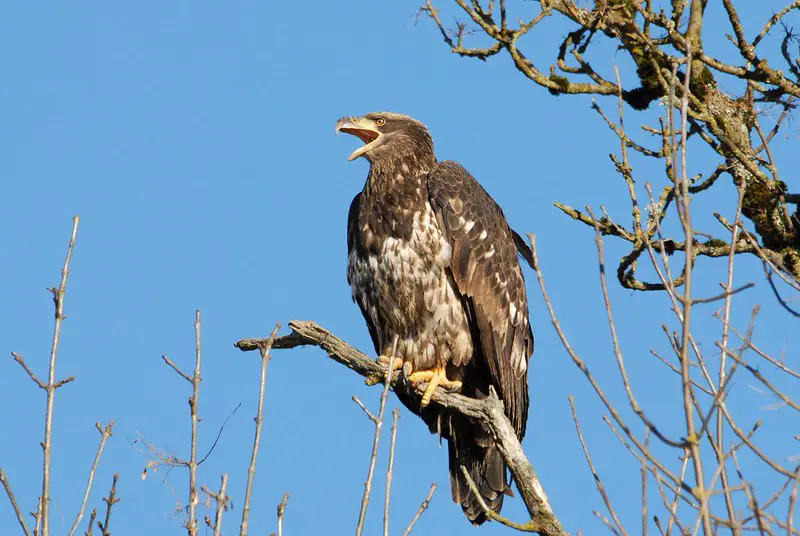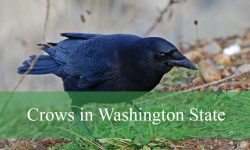Alabama’s diverse landscapes, from the Appalachian foothills to the Mobile-Tensaw Delta, offer ideal habitats for a variety of bird species. Among these, eagles stand out as some of the most impressive and fascinating raptors to observe.
The state is home to notable species such as the Bald Eagle, the Golden Eagle, and the Immature Bald Eagle. Each has distinct characteristics, from plumage to flight patterns, making them exciting for birdwatchers to identify in the wild.
Understanding these differences can greatly enhance your birdwatching experience. By recognizing their unique features and preferred habitats, you can enjoy closer and more rewarding sightings of Alabama’s majestic eagles.
Bald Eagle in Alabama: The National Symbol

The Bald Eagle (Haliaeetus leucocephalus) is one of the most iconic birds in the United States, symbolizing strength, freedom, and resilience. This majestic raptor is primarily associated with large bodies of water, such as rivers, lakes, and reservoirs, which provide abundant food and nesting opportunities. Bald Eagles are highly territorial during the breeding season and build massive nests, sometimes measuring up to 13 feet deep and 8 feet wide, often in tall, sturdy trees overlooking water.
Identification Features
Adult Bald Eagles are unmistakable due to their striking white head and tail, which contrast sharply with their dark brown bodies and wings. Their large, hooked beaks, sharp eyes, and powerful talons are bright yellow, giving them a distinctive and commanding appearance. Adult females are generally larger than males, weighing up to 14 pounds and measuring around 42 inches in length, with wingspans reaching 7 to 8 feet.
Immature Bald Eagles are more challenging to identify. They lack the pure white head and tail, instead displaying a mottled brown and white plumage. Their legs remain featherless, and their wings, when in flight, are held flat—an important difference from the slightly upturned wing tips of the Golden Eagle.
Behavior and Habitat
Bald Eagles are most commonly found near large, open water sources where fish and waterfowl are abundant. They are skilled hunters, using their exceptional eyesight to spot prey from great heights. Their hunting technique often involves swooping down to snatch fish from the water with their strong talons.
In addition to fish, they feed on small mammals, amphibians, and carrion when available. In Alabama, Bald Eagles can be observed year-round, with many northern migrants arriving during winter months. They are frequently seen perched in tall trees or soaring gracefully above rivers and wetlands, scanning for food or defending their territory. Bald Eagles are generally solitary or found in pairs, except during migration or at communal feeding sites.
Golden Eagle in Alabama: The Elusive Visitor

The Golden Eagle (Aquila chrysaetos) is less commonly seen in Alabama but occasionally appears during winter migration. Unlike the Bald Eagle, which favors water-rich habitats, Golden Eagles prefer open terrains such as fields, grasslands, and mountainous regions. These vast spaces provide ample hunting grounds for small mammals and birds, making them ideal for this stealthy predator.
Identification Features
Golden Eagles are large raptors with dark brown plumage, accented by lighter golden-brown feathers on the back of the neck, which gives them their name. Their legs are fully feathered, and they possess long, pointed wings adapted for soaring and high-speed hunting. One distinguishing feature is that the primary feathers curve slightly upward at the wingtips when in flight. Immature Golden Eagles display dark plumage with scattered white patches on the wings and tail, which can sometimes be mistaken for juvenile Bald Eagles, but they lack the white head and tail of adult Bald Eagles.
Size and Physical Characteristics
Adult Golden Eagles can reach lengths of 30 to 40 inches, with wingspans ranging from 6 to 7.5 feet. Females are generally larger than males, weighing between 9 to 14 pounds. Their powerful talons and strong, hooked beaks make them formidable hunters, capable of seizing prey much larger than themselves relative to their size.
Habitat and Behavior
Golden Eagles favor open and rugged landscapes where they can use their exceptional eyesight to spot prey from high above. In Alabama, sightings are rare and usually occur during the colder months when northern populations migrate southward. They are solitary hunters, often seen soaring alone or in pairs, using their speed and agility to swoop down on unsuspecting prey.
Feeding and Hunting
Golden Eagles primarily hunt small to medium-sized mammals, including rabbits, squirrels, and ground-dwelling rodents. They are also capable of preying on birds and occasionally carrion. Their hunting technique involves soaring at great heights to locate prey, followed by a rapid, precise dive to capture it with their powerful talons. This combination of keen vision, speed, and strength makes the Golden Eagle one of the most efficient raptors in North America.
Immature Bald Eagle: The Growing Juvenile

Immature Bald Eagles, also called juvenile Bald Eagles, are often confused with Golden Eagles due to their similar dark plumage. These young raptors are in a transitional stage of development, gradually gaining the distinctive features of adult Bald Eagles as they mature over 4 to 5 years.
Identification Features
Juvenile Bald Eagles have predominantly dark heads and tails, with brown wings and bodies mottled with varying amounts of white. Their legs are featherless, which distinguishes them from Golden Eagles, whose legs are fully feathered. Another key difference is in flight: juvenile Bald Eagles hold their wing feathers flat while soaring, whereas Golden Eagles’ primary feathers curve upward at the tips. Over time, juvenile Bald Eagles will develop the iconic white head and tail feathers of adults, making identification easier.
Habitat and Behavior
Immature Bald Eagles are usually found in the same habitats as adults, often near rivers, lakes, and reservoirs. They spend much of their time practicing hunting skills and learning to navigate their environment. Young eagles may scavenge as well as hunt for fish, waterfowl, and small mammals. Observing juvenile Bald Eagles in Alabama offers a unique opportunity to see these raptors develop their hunting techniques and grow into the powerful, majestic birds that symbolize strength and freedom.
Comparison of Eagles in Alabama
Feature |
Bald Eagle |
Immature Bald Eagle |
Golden Eagle |
|---|---|---|---|
Scientific Name |
Haliaeetus leucocephalus |
Haliaeetus leucocephalus |
Aquila chrysaetos |
Plumage |
Adult: White head and tail, dark brown body and wings |
Dark head and tail, brown body with white mottling |
Dark brown with golden-brown feathers on neck; juveniles have white patches on wings and tail |
Legs |
Featherless |
Featherless |
Fully feathered |
Size |
28–42 in long; wingspan 6–8 ft; 8–14 lbs |
Slightly smaller than adults; similar wingspan |
30–40 in long; wingspan 6–7.5 ft; 9–14 lbs |
Habitat |
Near lakes, rivers, reservoirs |
Same as adults, near water |
Open fields, mountains, rugged terrain |
Behavior |
Soaring, perched near water; territorial |
Learning to hunt; practicing skills |
Solitary or in pairs; powerful flight and hunting |
Diet |
Fish, waterfowl, small mammals |
Fish, small mammals, waterfowl; learning to hunt |
Small to medium mammals, birds, occasionally carrion |
Flight Pattern |
Broad wings; flat wing tips |
Flat wing tips, less experienced flight |
Long, pointed wings; primary feathers curve upward at tips |
Presence in Alabama |
Common, especially winter |
Common near adult Bald Eagles |
Rare, mainly during migration |
Best Places to Spot Eagles in Alabama
Alabama offers several prime locations for eagle watching, each providing unique opportunities to observe these majestic birds. Lake Guntersville State Park is particularly well-known for its Eagle Awareness program, attracting visitors eager to see Bald Eagles during the winter months.
The Mobile-Tensaw Delta serves as a significant nesting site for Bald Eagles, allowing birdwatchers to witness them in their natural habitat amidst the wetlands.
Talladega National Forest occasionally hosts Golden Eagles during migration periods, offering a rarer but exciting sighting for enthusiasts. When visiting these locations, bringing binoculars and a camera with a good zoom lens is highly recommended to capture eagles in flight or perched high in the trees.
Conservation Efforts and Legal Protections
Both the Bald and Golden Eagles are protected under the Bald and Golden Eagle Protection Act, which prohibits anyone, without a permit, from taking, possessing, or disturbing these birds. Conservation efforts in Alabama have led to a steady increase in Bald Eagle populations, with more than 100 nesting pairs documented in the state.
Conclusion
Understanding the characteristics and behaviors of the Bald Eagle, Golden Eagle, and Immature Bald Eagle enhances the birdwatching experience in Alabama. By familiarizing yourself with their distinct features and preferred habitats, you can enjoy observing these magnificent birds in the wild. Remember to respect their space and adhere to local guidelines to ensure their continued protection and conservation.
FAQs about Eagles in Alabama
What types of eagles can be seen in Alabama?
Alabama is home to Bald Eagles, Immature Bald Eagles, and occasionally Golden Eagles. Bald Eagles are the most commonly observed, especially near rivers, lakes, and wetlands. Golden Eagles are rarer and typically appear during winter migration.
When is the best time to see eagles in Alabama?
The best time to observe Bald Eagles is during the winter months, from December to February, when northern populations migrate south. Golden Eagles are usually spotted during colder months as well, although sightings are less frequent.
Where are the best locations for eagle watching?
Prime eagle-watching spots include Lake Guntersville State Park, the Mobile-Tensaw Delta, and Talladega National Forest. These areas provide suitable habitats for feeding, nesting, and migration stopovers.
How can I distinguish between Bald Eagles and Golden Eagles?
Adult Bald Eagles have a distinctive white head and tail, with dark brown bodies and yellow beaks and talons. Golden Eagles are dark brown with golden feathers on the back of the neck, feathered legs, and slightly upturned wingtips in flight. Juvenile Bald Eagles may resemble Golden Eagles but have featherless legs and flat wing tips.
What do eagles eat in Alabama?
Bald Eagles primarily feed on fish, waterfowl, and small mammals, while Golden Eagles hunt small to medium-sized mammals, birds, and occasionally carrion. Juvenile Bald Eagles learn to hunt over time and may scavenge in addition to fishing.
Do eagles migrate in Alabama?
Some Bald Eagles migrate from northern states to Alabama during winter, while others are year-round residents. Golden Eagles are mostly migratory and are only occasionally seen during colder months.






